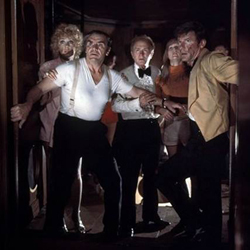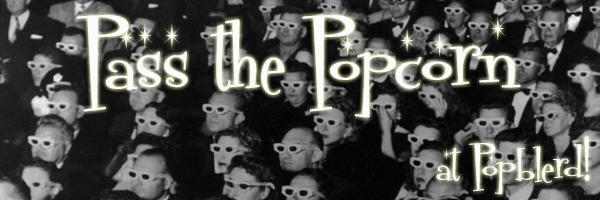 I remember watching and loving The Poseidon Adventure as a child. Even though I was a total baby and never had a very strong stomach for movies that threatened my sense of security, I remember being drawn to the characters enough to brave their disastrous circumstances with them. I was interested to see how the film would hold up years later–would it still be effective, or would it fall victim to that classic sentence, “It hasn’t aged well”? Well, having recently re-watched it on a whim, I’m delighted to say that it’s as effective as ever and just as good as I remembered it.
I remember watching and loving The Poseidon Adventure as a child. Even though I was a total baby and never had a very strong stomach for movies that threatened my sense of security, I remember being drawn to the characters enough to brave their disastrous circumstances with them. I was interested to see how the film would hold up years later–would it still be effective, or would it fall victim to that classic sentence, “It hasn’t aged well”? Well, having recently re-watched it on a whim, I’m delighted to say that it’s as effective as ever and just as good as I remembered it.
As a disaster thriller, The Poseidon Adventure functions both effectively and admirably, in spite of (and often because of) its retro 70s charm. It handles the inherent terror and suspense of its upended-cruise-liner scenario with fearless ease, placing its characters in danger after danger without once sinking into tired cliché. The success of the film is due in large part to the believability of the characters themselves, not just in their reactions to crisis but in their consistent and distinctly human personalities. Impeccably cast and confidently performed, the strongly delineated group of survivors carry the story, inviting the viewer to grow invested in their quirks, strengths, and weaknesses, their heroisms and their griefs.
But perhaps most striking about The Poseidon Adventure is that, in addition to succeeding as a disaster film, it simultaneously imbues its tale with a poignant overall theme of choice—the choice not just to passively survive, but to actively fight for life in the face of death and to believe in hope when all hope seems to be lost. Manifested in the courageous resilience of Gene Hackman’s Reverend Scott, this will to live constitutes the driving force of the story, overcoming not just physical hazards but—perhaps even more hazardous—confrontations with other people as well.
And it’s those human interactions that highlight one of the core strengths of the film: the fact that the overturned Poseidon, like the setting of any good disaster movie, functions almost expressionistically as a microcosm for the world itself—indeed, for any environment in which people need to choose how to act under oppressive circumstances. The confrontations in the film hinge on precisely that: the differing ways in which people choose to act in the upside-down world they find themselves in. Some choose to place their trust in authority (the majority of the people on the ship—including the ship’s chaplain—listen to the purser and remain in the dining hall, only to drown moments later), while some choose to listen to reason, following Reverend Scott instead of waiting for help that won’t possibly arrive in time.
The fact that both of these courses of action are supported and defended by a man of God—one by the chaplain and the other by Reverend Scott—demonstrates the double-edged nature of faith in the film. Those who remain in the dining hall place their faith in authority, trusting that God will send someone to save them, while those who leave are taking a cue from Reverend Scott’s sermon earlier in the film by placing faith in their own strength, by “praying to that part of God within [them].” Both can be (and are) interpreted as faithful behaviors—but only one leads to survival.
The danger of blind or misplaced faith can be seen again later, when the group encounters another group of survivors being led away from the stern by the ship’s doctor. The doctor, having heard and felt explosions rock the ship, assumes that the engine room is gone. Reverend Scott asks the doctor, “Did you check the engine room? Did you see it?” The doctor says, “I don’t have to, we’re going forward!” This blind assumption mirrors (and is foreshadowed by) the doctor’s attitude in an earlier scene in the film, in which Ernest Borgnine’s Rogo confronts him about his diagnosis of Linda, complaining, “How do you know she’s just seasick? … You didn’t even examine her!” Similarly, how does the doctor know the engine room is gone if he hasn’t examined it first?
But Rogo levies the same line of questioning upon Reverend Scott, who says, “They’re going toward the bow. They’re wrong. The bow’s underwater!” In response, Rogo—in a line of dialogue that could have been taken straight from 12 Angry Men—asks, “How do you know? Have you seen it? What makes you so damned sure about everything? If all those people think they’re right by going up there, maybe we should go with them and not you!” Yes, Reverend Scott has just as much information as everyone else, and is going on faith just as much as the doctor is—but the difference is that he’s not allowing despair to cloud his judgment. Life, if it’s to be had, lies in the direction of the stern—and that’s not just faith, that’s reason.
Luckily for Rogo, he ultimately listens to Reverend Scott, following him to the bitter end. And in the final moments, when the bitterness of that end seems to have finally overwhelmed him, Rogo is reeled back from the pit of despair by a rousing entreaty from Red Buttons’ Martin: “What kind of a policeman were you? You’ve done nothing but beef and complain. Always negative, always constructive. Well now’s your chance to do something positive for a change! Are you quitting, Mr. Rogo? Are you going out with a whimper, on your belly?”
Martin, who started out as the shiest, gentlest character in the film, ends up being one of the strongest, channeling Reverend Scott’s renegade energy when the survivors need it most. Martin’s earnestness in that moment is the essential earnestness of the film itself. It’s an earnestness that strips reality down to its most basic question, that unearths the most basic truth, a truth that’s true even when the world around us is turned upside-down: that we can either give up or we can fight, and that “life always matters—very much.”
Grade: A-

